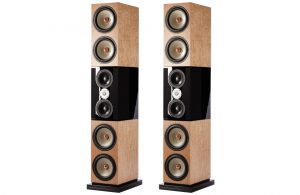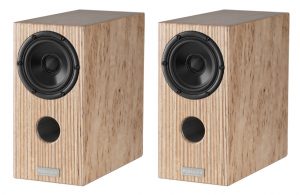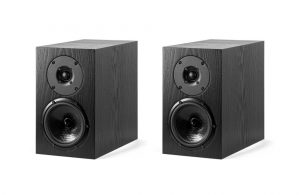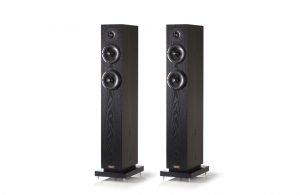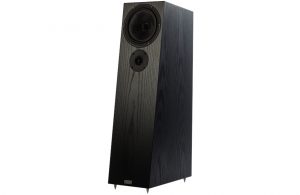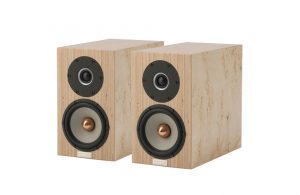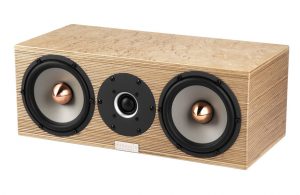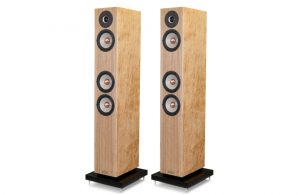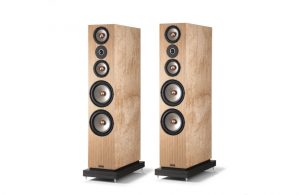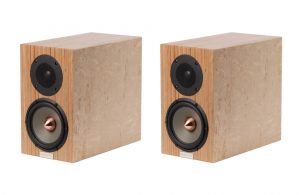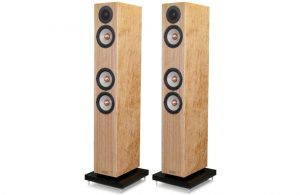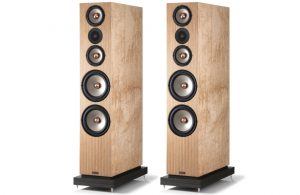PENAUDIO / Karelia
-
Visiter le site de la marque
Penaudio Karelia gathers all the knowledge, passion, competence and craftsman work together that has been born within 22 years of business.
Penaudio Karelia is not just an ordinary loudspeaker where there are drivers and cabinet. It is far beyond that. Although it has, of course, drivers and cabinet Karelia uses acoustics in its cabinet to control sound directivity.
As it is very well known that all the dynamic loudspeakers have problems in bass area 20 — 200 Hz that is caused by standing waves and reflections. In a regular box whether it is closed, reflex loaded or transmission line the sound is in this area omnidirectional i.e. bass notes leaves cabinet in all directions so actually you are listening to the room, not loudspeakers.
High frequencies produced from tweeter are because of sound basics principle cardioid i.e. sound leaves driver like light from flashlight direct to listener. High frequencies actually have no problems in normal room conditions as even the smallest particles for example, carpet, houseplants, books in shelves, dampens and diffuse those frequencies.
Mid frequencies produced by midrange drivers are hemisphere so sound leaves the driver in 180 degrees forward and spreads there everywhere. That starts to be a problem even in normal room conditions. Mid frequencies need bigger particles to diffuse/absorb unwanted reflections. Those would be really thick carpet, sofa with lots of pillows, huge shelf with unsymmetrically assembled books, etc.
Low frequencies as I earlier mentioned are omnidirectional i.e. all the sound goes everywhere. So that is a big problem because you need such huge particles to absorb/diffuse unwanted reflections that it is extremely difficult or even impossible to even fit them into a room.
In Karelia highs are cardioid and mids and lows dipole. So that means that all the sound is pointed to the listener without unwanted reflections. So it means like comparing a search for a person from dark woods using the campfire vs. the flashlight. So instead of listening actually to the room that I explained earlier you are listening to pure sound from drivers.
And by choosing the best drivers available we can get so close to real sound that it is breathtaking.
Midrange section uses carefully measured holes in sides and in front forcing sound leak controlled making phase difference that ends up to dipole where its back wave (as dipole radiates sound as much front and back BUT nothing to sides (left-right, up and down)) is dampened so there is no back wave. That polar pattern makes midrange so clean combined with latest Seas Excel technology by using CURV cone (woven propylene cone with short cut rings below and above pole piece, stiff spider and titanium voice coil former) that it is extremely lifelike.
Woofer section uses a dampened U-frame that is dipole but acts as cardioid (no back wave = no unwanted reflections) almost to the lowest notes. By this extremely controlled damping we create phase difference between front and back wave and manage to get response to 25 Hz.
And as lowest notes Karelia acts as a dipole you need to have at least 40 cm free space behind it as otherwise low notes are decreased because of a back wall response that creates phase difference to “wrong” area. Woofer drivers are specially made for this project by Seas. They are magnesium/aluminium coned Excels modified to fit this kind of cabinet structure.
Drive units :
26 mm artificial diamond dome tweeter Seas Excel with patented neodymium based system based on 6 radially magnetized NdFeB magnet blocks. Efficient ventilation and damping of every potentially resonant cavity behind the dome, surround and voice coil. Precisely mounted copper sleeve reduces non-linear and modulation distortion. The final cuts of the acrylic rear chamber help scatter the internal sound waves with a minimum of damping. Together with a non-resonant magnet system, this provides the high dynamic response of the tweeter.
2 x 176 mm OEM Seas Excel Curv, woven polypropylene cone midrange. A new woven polypropylene with excellent internal damping together with perfectly matched moving parts, titanium voice coil, short cut rings above and below the T shaped pole piece, specialy designed spider to match dipole design cabinet.
4 x 269 mm OEM Seas Excel magnesium/aluminium alloy cone, copper rings above and below the T shaped pole piece.Cross-over :200, 4500 HzFrequency range in room response :25 — 65000 HzSensitivity :87 dB/1 m/2,83 VNominal impedance :4 OhmsRecommended amplifier :>30 WDimensions (WxHxD) :330 x 1800 x 440 mmWeight :80 kgSpecial :Mundorf MResist Supreme resistors, Mundorf MCapEvoSilverGoldOil and MCapEvoOil capacitors, Mundorf Hepta Strand and MCoil Air Core inductors, WBT pole screws, midrange cabinet uses dipole acoustic system and with damped back side it makes it cardioid in its working range, woofers uses U-frame dipole structure that with heavy damping makes it cardioid above 50 Hz and dipole below 50 Hz.Autres produits de la marque PENAUDIO


